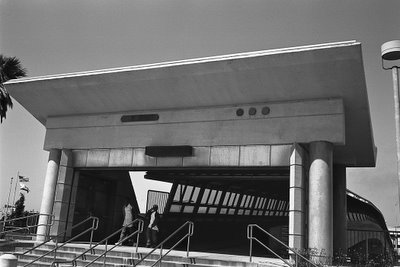The one camera that has intrigued me (along with the Leicas), was the Canon P. I tried several times in auctions to acquire one, but the price for a good one, with a smooth shutter curtain always shot past what I was willing to pay. I've always had my eyes peeled for one locally, but it never came up. I finally got one off a seller on RFF, and it's safe to say it's all good, now.

~click images for a larger view~
I've heard the P described as "the sweet spot" in the evolution of the rangefinder camera. I don't know about that, but I think it's safe to say it is the sweet spot in the Canon line of V/L cameras.
It is a beauty to look at, and could easily be the prettiest RF camera around. I've seen pictures of the very rare black version of the P (see Cameraquest.com), and I know it is highly collectible, but to me the black version lacks the beauty of the chrome.
Sure It's Pretty, But How does It Handle?My initial impression of shooting with the camera is that it handles beautifully. The P is small and has a very nice heft to it. While the viewfinder is a little cluttered with frame lines, and seemed a little flare-ish at times, it is much brighter than the VL. The P is quick and a pure joy to use
My only complaint is with the film advance lever. I like to shoot with my thumb under the advance lever, and with most of my cameras (like the M pictured below) I have that luxury.

With the P I can't do that. It locks down and won't budge beyond a few millimeters (see below).

I tried cocking the shutter and then not allowing it to return all the way, but I started running into film-advance problems, where the shutter wouldn't fire until I fully cocked it, moving the advance mechanism from its start point to the end point, and back again (locking the advance arm).
Using it normally, to advance the film, you have to change your hand position very slightly to get at the tip of the advance lever (compare the thumb positions above). This is no big issue, really. I mean I'm not a photojournalist, nor am I missing important shots because I'm having to slightly change my thumb position. It's really very minor.

The P does strike me as being one of the quieter cameras that I've used. I'm not sure if that is true or not, I'll have to do a comparison. The metal curtain gives it distinct sound, higher in register and different from the Leica's muffled cloth curtain "schwoop." I would place it in the broad range of rangefinder shutter sounds lying between the Leica and the Bessa R & R2, which has a metal shutter, resulting in a sound that reminds me of an SLR. I'm not referring to volume here, but sounds. I'm staying away from the "volume debate. " I did a non-scientific volume comparison between an M7 and a R2, and was amazed that the R2 wasn't louder, as I thought it would. It was just different.

Btw, the lens pictured on this P is a Canon 50/1.8.
Anyway...If you like shooting rangefinder cameras, for all the normal reasons we all do (e.g., small, quick-handling, quiet, great optics, quality construction) you would absolutely love shooting with the Canon P. I now know why it has its proponents, and why they are so adamant about what a great camera it is.



















 ~click images for a larger view~
~click images for a larger view~








